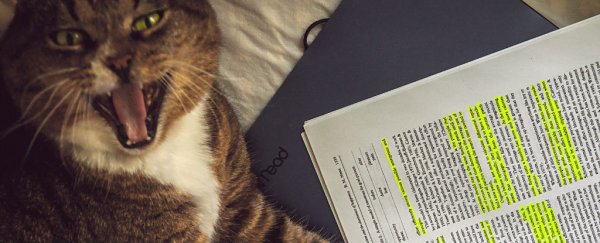Let's be real here - getting research papers published is hard. But what if you could use your cat to cut through all that bureaucracy and get your paper into the journal of your choice. You'd give it a shot, right?
It wouldn't fly now, but back in 1975, it was a whole different story, because a cat named F.D.C. Willard was the co-author of a peer-reviewed physics paper called "Two-, Three-, and Four-Atom Exchange Effects in bcc 3He."
Published in the journal Physical Review Letters, the paper describes the results of an experiment exploring the behaviour of the helium-3 isotope at various temperatures.
Conducted by Jack H. Hetherington, a professor of physics at Michigan State University, the experiment yielded important insights that are still being referenced today, but when Hetherington tried to submit it for publication, there was a problem.
"I had submitted the paper … and was rather proud of the work, considering it suitable for rapid publication in Physical Review Letters," Hetherington told author R. L. Weber for his 1985 book, More Random Walks in Science.
"Before I submitted it, I asked a colleague to read it over and he said, 'It's a fine paper, but they'll send it right back.'"
Why? Hetherington had opted to use the royal "we" in his paper rather than "I", and the journal had a specific rule that prohibited the use of "we" unless the paper had multiple authors.
"Changing the paper to the impersonal seemed too difficult now, and it was all written and typed; therefore, after an evening's thought, I simply asked the secretary to change the title page to include the name of the family cat, a Siamese called Chester," Hetherington explains.
Chester, the son of a cat named Willard, who Hetherington describes as "one of the few unfixed male Siamese cats in Aspen, Colorado", was given the pen name of F.D.C. Willard, which stands for Felis Domesticus Chester Willard.
As you can see here, the paper was accepted, and F.D.C. Willard from the Michigan State University physics department was an officially published cat.
As nice as it must have been for Chester to suddenly be an expert on particle physics, surely it would have made more sense for Hetherington to just find an actual colleague in the physics department and throw their name on the paper instead?
Well, there's actually a whole lot more method to this madness than you might think, because Hetherington wasn't particularly interested in sharing the spotlight with someone else when he did all the work.
He told Weber that he was conscious of the fact that researchers' pay and reputation is partly based on their research output, and didn't want that diluted. He also suspected that if everyone found out the co-author was a cat, well, that's just free publicity.
"In any case, I went ahead and did it, and have generally not been sorry," he said. "Most people are amused by the concept, only editors, for some reason, seem to find little humour in the story."
Ten lucky friends of Hetherington's got signed copies of the paper, and F.D.C. Willard was happy to lend a paw print, but the identity of the mysterious co-author was only made known to the public after someone asked to speak to this Willard character at Michigan State.
"[A] visitor asked to talk to me, and since I was unavailable, asked to talk with Willard. Everyone laughed and soon the cat was out of the bag," Hetherington told the Today I Found Out website.
 More Random Walks in Science, R. L. Weber
More Random Walks in Science, R. L. Weber
F.D.C. Willard went on to publish another article on helium-3 in the French science magazine, La Recherche - and this time as the sole author - before fading into obscurity once more.
But far be it from physicists to forget their feline compatriot. On 1 April 2014, the American Physical Society (APS) announced that all cat-authored papers would be available as open-access documents:
"APS is proud to announce a new open access initiative designed to further extend the benefits of open access to a broader set of authors. The new policy, effective today, makes all papers authored by cats freely available. … Not since Schrödinger has there been an opportunity like this for cats in physics."
If both NASA and cats are on the open-access train, you know it's good. We salute you, Felis Domesticus Chester Willard.
